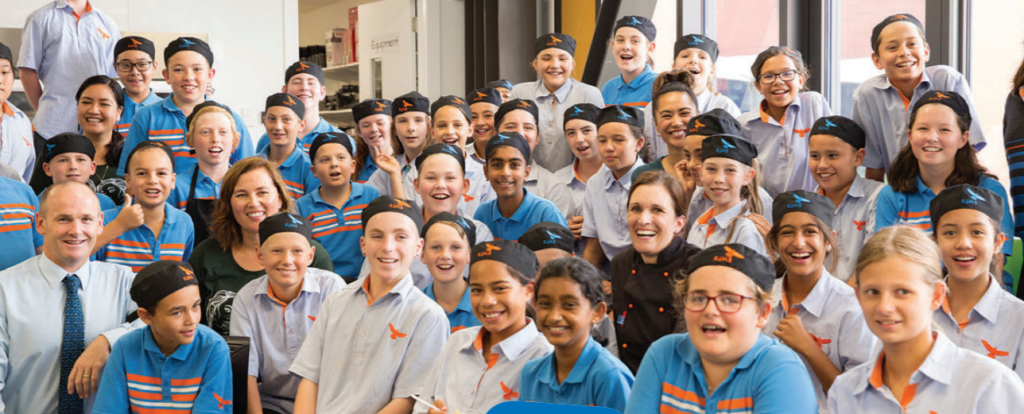Co-Teaching with Food Technology
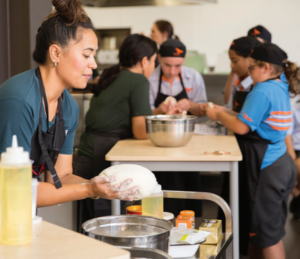
Rototuna Junior High School is a middle school catering for students in Years 7 to 10. Our school shares the campus and some facilities with the recently opened Rototuna Senior High School, situated in the rapidly growing North East of Hamilton. A strong connection with local iwi Ngati Wairere, underpins the vision and values of the school. The local history has influenced the naming and design of areas within the school and the curriculum.
Learning module units are co-constructed, taught and assessed collaboratively by
teachers from several curriculum learning areas in response to student needs and
interests. These modules foster deep learning and student engagement, with meaningful connections across learning areas.
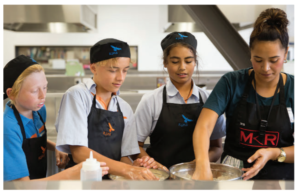
Nadine Malcom-Cant and I were excited to be paired to teach a year 7 and 8 Te Reo Maori and Food Technology module this semester. So far we have sparked lots of ideas around the name of our module ‘Kai and Who am I?’ What we already knew is that one of the most authentic ways to experience a culture, the language, traditions and history, is through food. We started the sparking phase by getting our students in Umu (our food technology room) the beginning of their learning journey by growing their own starters inspired by Matua Anarau from our senior school who came in to share his home cooked loaf of rewana bread and a portion of his nanny’s starter for the module to keep. During our seeking phase we learned the science behind fermentation using potato and used our senses to compare it to our own yeast bread, and with all of this learning we really enjoyed listening to Matua Anaru who believes the need to embrace ‘aroha’ when cooking.
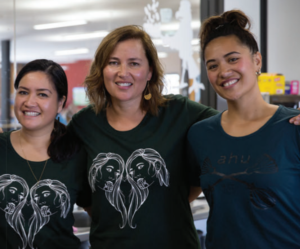
Integration
Nadine is the specialist learning leader of languages and the te reo Maori teacher.
Prior to Rototuna Junior High, she worked with staff from various schools around the Waikato on setting up effective te reo Maori programmes. She has a keen interest also in second language aquisition.
Our students are learning Te Reo Maori, the indigenous language of Aotearoa,
New Zealand. Over food, we are telling stories, developing strong relationships,
and perhaps leaving a legacy of what will become a strong foundation for AKO.
Students will lead converstations at the Matariki lunch, and teachers will respond
with the guidance of our students.
We believe that relationships are key in connecting with our students and creating
inspiring learning opportunities such as inviting guest speakers and making
use of our space and the links within our community. We have observed our
learners engage at many different levels, and feel lucky to have such varying and
differing areas of expertise, to enable us to better collaborate with our students
and to thoughtfully live with the nature of technology that shape our lives today and toward the future.
We hope for our learners to understand the ethics around food customs, and have a philosophical understanding of the issues surrounding historical, contemporary and future scenarios of Maori Kai. There is a real, rich culture of food between Maori and the early settlers, It was a melting pot of not only these new ingredients, but also the ways Maori prepared food.
MKR – Too blessed to be stressed!
We invited MKR contestants, Rotorua besties, Hera and Tash to cook and to share some of their traditional and contemporary kai, the stories of their whanau and upbringing behind recipes, traditions and embrace Maori Cuisine. Another learning module (Visual Arts and Technology parked their module for their block) lead by Anna Pratt to capture moments of students lapping up every word as Hera and Tash did a wonderful job of weaving natural, real indigenous ingredients into a collection of vibrant, fl avorful and approachable recipes. They tied in our te reo language beautifully as they demonstrated, just enough for our students to begin to learn how to share back during their Matariki lunch. Each student will be speaking te reo when asking our entire staff during our Matariki celebration lunch if they would like to try Maori cuisine he rewana mau? Would you like some rewana bread? He paraoa parai mau? Would you like some fried bread? Ae koa! Yes, please! This is yummy! He reka! Students will also stand during the kai to
present their pepeha which of course was inspired by the name of the module’ kai
and who am I?’ A take away from Tash and Hera’s visit, is to be open to what is out there and to embrace Maori culture and cuisine.
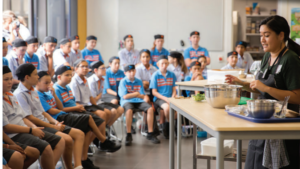
Development of the Menu
Later on in this term our students will continue to follow our schools learning process, they will design and evaluate their own prototypes while complimenting Hera and Tash’s menu, adapting the recipes in response to a given brief. Stakeholder feedback will enable students to refine their practice allowing students to have agency. Students will go foraging and cook in Pirongia’s forest with their Indigenous ingredient lead by Charles Royale who will support their understanding of medicinal properties of edible plants. Students will be inspired to trial and test new concepts toward our matariki menu depending on our staff’s dietary needs and feedback, allowing for their prototype to hopefully become a realised outcome. To take something traditional that we all know from growing up, but put a twist on it.
Context: Kai has the power to bring people together and to help us better understand each other. One of the most authentic ways to experience a culture and learn about its traditions, history and language is through food.
Issue: Despite Maori having a rich and unique culinary heritage, you won’t find any Maori fine dining restaurants anywhere. What can we do as kiwis to keep
Tikanga alive?
Brief: You are to develop an indigenous menu item that fuses traditional with
contemporary. You will be required to speak full te reo when serving kai for 120 people at a Matariki lunch held at RHS. The menu must address the needs of stakeholders attending the lunch.
Specifications:
Your menu item must:
– Include at least one locally sourced foraged ingredient Be developed within 100 minutes.
– Utilise In-season vegetables or fruit Resemble a finger food, so it is easy to eat
without cutlery.
